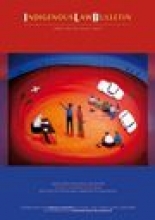March/April 2010 Volume 7 Issue 17

Editorial
Welcome to the March/April issue of the Indigenous Law Bulletin! Leon Terrill opens this general edition with an examination of Indigenous land rights reform as it has been unfolding around Australia. Leon questions the extent to which current trends can be explained by reference to economic imperatives, and how much they stem from bureaucratic convenience.
Vavaa Mawuli of the Public Interest Advocacy Centre revisits the challenges faced by NSW stolen wages claimants and explains the way in which last year’s updated guidelines affect those seeking to recover their lost entitlements. Vavaa highlights that, while some progress has been made, there is still a way to go in ensuring that the State Government fulfils its promise to reimburse Aboriginal people the money properly owing to them.
It is well known that Indigenous people are disadvantaged in Australia’s legal system. Scott Ludlam and Chiara Lawry discuss some of the more pressing findings emerging from the 2009 parliamentary inquiry into access to justice, and the difficulties particular to Aboriginal and Torres Strait Islander people. The issues raised are complex and call for a raft of solutions that respond to the intersecting challenges of funding, geography, gender, age and education.
Karenna Williams, a Canadian law student on exchange at the University of New South Wales, shares some of the lessons she learned while working for the Sour Springs Longhouse and Haudenosaunee Standing Committee on Burials and Burial Regulation. Karenna contributed to ongoing efforts to secure the return of sacred Indigenous medicine masks from museums in Canada and the United States. In this edition, she explains the different legal approaches adopted by each country, as well as some of the practical challenges that can arise along the way.
In April, we read with some disappointment that, notwithstanding the recommendations of the National Human Rights Consultation Committee, Australia will not be pursuing a national bill of rights because it would be too ‘divisive’. The Government will instead introduce a human rights framework, which is intended to educate the community about rights in a less confronting way. It is timely, given this recent development, to reflect on some of the assumptions upon which the Consultation was based, and the way in which the Committee’s approach to the rights debate shaped its final recommendations. Andrea Durbach and Megan Davis deliver separate critiques of the Consultation and consider how its largely minimalist strategy failed the Australian – especially Indigenous – people.
Zrinka Lemezina
Editor
CONTENT
Indigenous Land Reform: An Economic or Bureaucratic Reform?by Leon Terrill
Stolen Wages: Evidentiary Challenges for Claimants by Vavaa Mawuli
Closing the Justice Gap for Indigenous Australians by Scott Ludlam and Chiara Lawry
Hadu:wis: Repatriation Efforts of the Haudenosaunee in the United States and Canada by Karenna Williams
A Missed Opportunity: The Foregone Conclusion of a National Human Rights Consultation by Andrea Durbach
Indigenous Rights and the National Human Rights Consultationby Megan Davis
Regular
Months in Review - March/April
Compiled by Rachel Smith and Zrinka Lemezina
